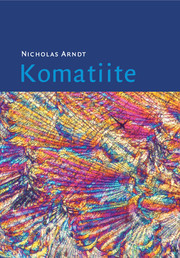Book contents
- Frontmatter
- Contents
- Preface
- Part I Background information – description of the field characteristics, mineralogy and geochemistry of komatiites
- Part II Interpretation – the manner of emplacement, the origin and the tectonic setting of komatiites
- 8 Physical properties of komatiites
- 9 Physical volcanology (by S. J. Barnes and C. M. Lesher)
- 10 Komatiite-associated Ni–Cu–PGE deposits (by C. M. Lesher and S. J. Barnes)
- 11 The hydrous komatiite hypothesis
- 12 Compositions and eruption temperatures of komatiitic liquids
- 13 Petrogenesis of komatiite
- 14 Geodynamic setting
- References
- General index
- Localities
- Plate section
13 - Petrogenesis of komatiite
from Part II - Interpretation – the manner of emplacement, the origin and the tectonic setting of komatiites
Published online by Cambridge University Press: 27 August 2009
- Frontmatter
- Contents
- Preface
- Part I Background information – description of the field characteristics, mineralogy and geochemistry of komatiites
- Part II Interpretation – the manner of emplacement, the origin and the tectonic setting of komatiites
- 8 Physical properties of komatiites
- 9 Physical volcanology (by S. J. Barnes and C. M. Lesher)
- 10 Komatiite-associated Ni–Cu–PGE deposits (by C. M. Lesher and S. J. Barnes)
- 11 The hydrous komatiite hypothesis
- 12 Compositions and eruption temperatures of komatiitic liquids
- 13 Petrogenesis of komatiite
- 14 Geodynamic setting
- References
- General index
- Localities
- Plate section
Summary
Nature of the komatiite source
If we accept the arguments developed in Chapters 11 and 12, we can conclude that high temperature is the defining feature of the komatiite source. This immediately rules out a number of possible settings for the formation of komatiites such as subcontinental lithospheric mantle, the mantle wedge above a subduction zone, and a mid-ocean ridge, where temperatures are most unlikely to have been high enough to generate the highly magnesian anhydrous parental magmas of komatiites. What is required is a source whose temperature is significantly higher than that of ambient mantle. Unless the effect of high temperature was counterbalanced by its composition – an elevated content of Fe or garnet, for example – the source would be less dense than surrounding mantle and it would have ascended at a rate that depended on its form and size and on the rheology of the surrounding mantle.
We have no real idea of the exact nature of a komatiite source but a mantle plume probably fits the bill. The source could have been a mantle plume of the type thought (by most authors) to be feeding Hawaii and other chains of oceanic islands – a cylinder of hot, buoyant material rising from deeper in the mantle – or it could have been a ‘starting mantle plume’ – a huge, roughly mushroom-shaped structure that probably rose from the core–mantle boundary.
- Type
- Chapter
- Information
- Komatiite , pp. 363 - 389Publisher: Cambridge University PressPrint publication year: 2008
- 1
- Cited by



